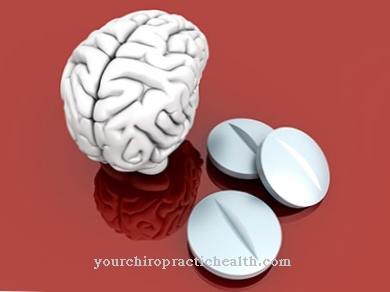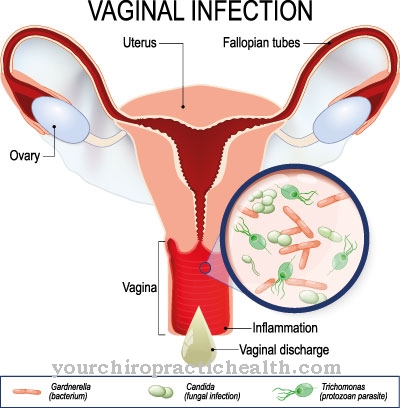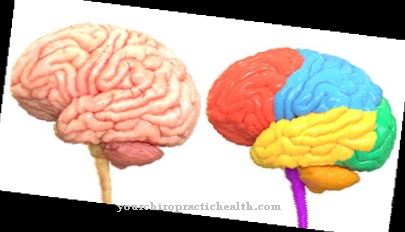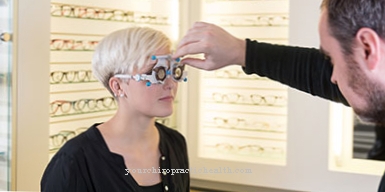Widespread disease back pain - Almost one in four Germans regularly suffers from pain in the back area. One reason for this can be the so-called Hunchback, i.e. a back curved back, which is particularly widespread in industrialized nations.
What is a hunchback?

© endostock - stock.adobe.com
Of the Hunchback, in medicine as Hyperkyphosis denotes that is derived from the Greek of "kyphos" for "hump" and "hyper" for "over", denotes an extreme backward curvature of the spine.
A kyphosis in the thoracic vertebra area and a smaller one at the level of the coccyx (sacral cyphosis) are completely normal and natural.
Only in the case of an extreme bulge, which is clearly visible when standing upright, is there a hunched back, which is then referred to as "hyperkyphosis".
A distinction is made between innate hunchbacks and those that arise after birth.
In the long term, hyperkyphosis can also lead to organ damage and psychological stress.
causes
The main reason for one Hunchback is a lack of movement combined with incorrect or unnatural postures when sitting, standing or walking.
These bad postures as well as the often too weak muscles lead to the fact that this is no longer able to guarantee a correct, upright posture. As a consequence of this, the vortex vibrations can collapse and so gradually bend the back.
If these faulty conditions persist over a longer period of time without counteracting by building muscles or a more active lifestyle, this inevitably leads to the development of a hunched back.
In older people, a vertebral fracture, which can be triggered by osteoporosis, for example, can also be the cause of a hunched back. Degenerative diseases such as arthritis can also lead to the formation of a hunched back.
Symptoms, ailments & signs
The hunchback can be associated with many symptoms. Depending on the severity, these are not only symptoms in the area of the bony structures, but also in the area of the internal organs. The clearest sign of the hunched back is of course the arching of the upper back beyond the normal dimension. The kyphosis, which the thoracic spine normally has, is far more pronounced than is physiological.
This is not only easy to see from the side, but also from the front, as the person concerned has a more or less visibly narrowed chest with shoulders that often fall forward. It is this narrow chest cavity that ensures that the hunched back can also show symptoms in the internal organs that have less space for their function.
The heart and lung function can be impaired as the space for breathing is limited by the hunched back. The stomach may also be influenced in its natural activity. The main symptoms of a hunched back, however, are to be found in the area of the support and movement system.
Back pain, neck pain and also headaches can be the result. The shortened muscles in the chest area and the weakened muscles in the upper back lead to a muscular imbalance, which can also lead to pain in muscles, tendons, ligaments and nerves.
Diagnosis & course
Diagnosing one Rounded back is one of the easier tasks for orthopedists and physiotherapists, as it is usually visible to the naked eye.
In order to get complete clarity, an X-ray of the spine can also be taken. The consequences of an untreated hunchback are diverse and should not be underestimated. In addition to more harmless symptoms such as slight headaches and back pain or a restricted range of motion, more serious sequelae such as sleep disorders, which can lead to psychological problems and even depression, can occur.
In addition, the hunched back can impair the unrestricted function of important organs such as the heart or lungs, as these can be affected by the curvature of the chest. Without targeted treatment, the curvature of the spine increases and can lead to damage to the spinal cord and consequential damage to other areas of the musculoskeletal system.
Complications
A hunched back is always accompanied by overstretching and compression, which inevitably lead to damage to muscles, tendons, vertebrae and connective tissue. This is associated with painful tension, but also disc damage and signs of wear and tear. The most stress is placed on the lower spine area - pain in the lumbar and sacral vertebrae and restricted mobility occur.
In the shoulder area, a hunched back can cause inflammation in the bursae. If the nerves are impaired, functional disorders occur in different parts of the body. There is numbness or tingling in the arms and legs, and complications such as incontinence or urinary retention occur in the bladder and rectum. A hunched back has a negative effect on performance and wellbeing.
The chronically ill therefore often also suffer from mental ailments. Treatment also carries risks. Surgical intervention carries the risk of nerve damage, bleeding and infection. Wound healing disorders and secondary bleeding delay the healing process and can occasionally cause major complications.
Prescribed painkillers can occasionally trigger complaints such as headaches, body aches or gastrointestinal complaints.In interaction with other medications or illnesses, further problems can arise.
When should you go to the doctor?
A hunchback should be treated by a doctor. If left untreated, further compilations can occur, which can significantly limit and complicate the everyday life of the person concerned. An early diagnosis with subsequent treatment has a positive effect on the further course of the disease and can prevent further symptoms or complications.
A doctor should be consulted if the back shows an unnatural curve. In most cases, friends or family can point out the hunchback to the patient. Since the inner organs also have less space in the body due to the hunchback, these organs can be damaged. Often, permanent pain in the back or neck indicates these complaints, whereby the person affected can also suffer from severely weakened muscles. The pain often spreads to the neighboring regions.
If you have a hunched back, you can first see a general practitioner. However, further treatment is then carried out by a specialist.
Treatment & Therapy
The first treatment option for one Hunchback is in most cases physiotherapy. Both the back and chest muscles are specifically trained and built up.
In addition, there is the learning and independent application of special breathing techniques that are intended to relax and relieve the incorrectly strained muscles. In addition, there is the possibility of wearing a corset, which can be adjusted to the respective degree of severity of the hunchback using various options.
In particularly severe cases, surgery is even necessary. In the case of a hunchback caused by a vertebral fracture, e.g. a so-called kyphoplasty is performed, in which the broken vertebrae are stabilized again through the use of bone cement.
The best way to prevent a hunched back caused by a lack of movement and incorrect sitting postures is through regular exercise and correct posture when sitting. Most gyms nowadays offer courses in which exercises are performed that are specifically designed to stabilize the spine and strengthen the back muscles.
Regular jogging or walking is also beneficial for the back muscles and a correct posture and can counteract the development of a hunched back.
You can find your medication here
➔ Medicines for back painprevention
Of the Hunchback is a common phenomenon and should not be underestimated due to its potential consequences. But various therapies and options for prevention and prevention, such as sport, can counteract an already existing hunched back or prevent it from becoming a problem in the first place.
Aftercare
Follow-up care is often necessary for a hunched back if it was previously pronounced and therefore an operation had to be performed. Follow-up treatment takes place in collaboration with a specialized orthopedic surgeon and physiotherapist. The cooperation of the patient also plays an important role. So he should consistently continue the physiotherapy exercises that he learned as part of physiotherapy within his own four walls.
The physiotherapeutic exercises serve to gently stretch the shortened chest muscles. This, in turn, can treat the unhealthy curvature that tends towards the front. In addition, the exercises strengthen the upper back region, which promotes the physiological straightening of the spine. In rehabilitation sports, training units on devices that stimulate targeted strengthening of the muscles are possible.
Bed rest is not necessary after an operation on the hunched back. In this way, the patient can get up with someone just a few hours after the operation and can move around normally. However, a short-term fitting with a corset is recommended. To counteract the pain after the operation, the patient is given a special pain catheter. This stays on the body for a few days.
Regular isometric exercises to strengthen the core muscles are important for aftercare. In order to assess the postoperative consolidation of the hunchback, clinical control examinations are carried out and X-rays are made.
You can do that yourself
Patients with a hunched back can do various gymnastic exercises. You should contact a physical therapist and work out suitable measures. Proper exercise can improve spinal health. The posture can usually only be corrected to a limited extent. It is all the more important to avoid further damage through appropriate exercise strategies.
No strenuous physical activity may be performed after an operation. It is important to take care of your back and to contribute to recovery by means of targeted physiotherapy. In consultation with the specialist, natural remedies can be used to alleviate any pain. This not only solves immediate complaints, but also makes walking in a straight line easier. This reduces bad posture and prevents consequential damage such as joint wear. Hyperkyphosis can also be treated with breathing exercises. Targeted training increases the breathing volume and alleviates the shortness of breath that accompanies the widow's hump.
If these measures are followed consistently, a strengthening of the hunchback can be avoided. In addition, gymnastics and an active lifestyle can prevent further postural damage. Older patients in particular need to stay active in order to counteract hyperkyphosis.



























